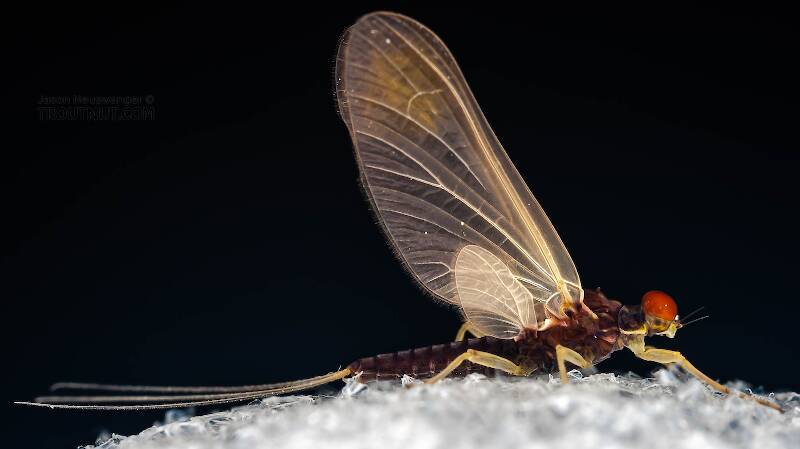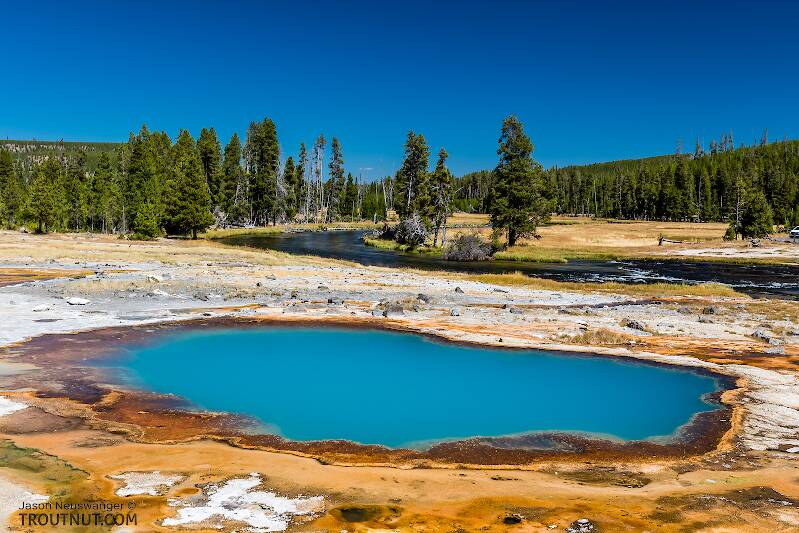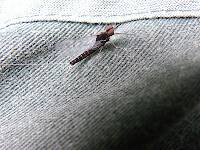
Salmonflies
Pteronarcys californica
The giant Salmonflies of the Western mountains are legendary for their proclivity to elicit consistent dry-fly action and ferocious strikes.
Featured on the forum

This specimen resembled several others of around the same size and perhaps the same species, which were pretty common in my February sample from the upper Yakima. Unfortunately, I misplaced the specimen before I could get it under a microscope for a definitive ID.

Troutnut is a project started in 2003 by salmonid ecologist Jason "Troutnut" Neuswanger to help anglers and
fly tyers unabashedly embrace the entomological side of the sport. Learn more about Troutnut or
support the project for an enhanced experience here.

See the comments for an interesting discussion of the identification of this dun.
GONZO on Jul 19, 2007July 19th, 2007, 4:51 am EDT
Jason,
Somehow, I don't think this is Serratella--it seems too large (especially for a male), and the "S" with which I'm familiar have very dark wings. I thought I'd call attention to it in the hope that someone might be able to offer some insight and, perhaps, clear up the mystery.
Somehow, I don't think this is Serratella--it seems too large (especially for a male), and the "S" with which I'm familiar have very dark wings. I thought I'd call attention to it in the hope that someone might be able to offer some insight and, perhaps, clear up the mystery.
Taxon on Jul 19, 2007July 19th, 2007, 5:23 am EDT
Gonzo-
It's a Paraloptophlebia male dun, lilely P. mollis. For verification, see the male dun on Hatches II Color Plate VII, and use some magnification on the photo to compare the distinctive hind wing costal cell venation to Jason's photos.
It's a Paraloptophlebia male dun, lilely P. mollis. For verification, see the male dun on Hatches II Color Plate VII, and use some magnification on the photo to compare the distinctive hind wing costal cell venation to Jason's photos.
Konchu on Jul 19, 2007July 19th, 2007, 5:28 am EDT
Those IDs were my guesses. I didn't pay any attention to the size aspect. New guess: maybe a Eurylophella?
Taxon on Jul 19, 2007July 19th, 2007, 7:37 am EDT
Hi Konchu-
I like your guess a lot better than mine. In retrospect, wish I'd initially characterized it thusly. The presence of some costal angulation in the hind wing in Jason's photos was a bit troubling to me, as Paraleptophlebia are customarily rounded, but ah well.
The Mayflies Of Florida by Berner/Pescador, which your enthusiastic recent reference motivated me to purchase, illustrates both the fore and hind wing venation of a male Eurylophella temporalis (previously Ephemerella temporalis).
The venation (of both fore and hind wings) is really close to Jason's photos, except for an interesting (apparent) absence of (costal) crossveins on the basal 75% of the wing in Jason's photos.
I like your guess a lot better than mine. In retrospect, wish I'd initially characterized it thusly. The presence of some costal angulation in the hind wing in Jason's photos was a bit troubling to me, as Paraleptophlebia are customarily rounded, but ah well.
The Mayflies Of Florida by Berner/Pescador, which your enthusiastic recent reference motivated me to purchase, illustrates both the fore and hind wing venation of a male Eurylophella temporalis (previously Ephemerella temporalis).
The venation (of both fore and hind wings) is really close to Jason's photos, except for an interesting (apparent) absence of (costal) crossveins on the basal 75% of the wing in Jason's photos.
Troutnut on Jul 19, 2007July 19th, 2007, 8:30 am EDT
I'll put it in Eurylophella for now. I'm sure it's some Ephemerellid; the body is too stout and the hind wing too wide to fit the general shape of a Paralep.
Jason Neuswanger, Ph.D.
Troutnut and salmonid ecologist
Troutnut and salmonid ecologist
Konchu on Jul 19, 2007July 19th, 2007, 9:37 am EDT
The forceps also are ephemerellid-like.
Dhfunk on Feb 24, 2008February 24th, 2008, 11:41 pm EST
This is definitely Ephemerella needhami. I have photos of subs I reared from this region that look exactly like the posted photo. All Eurylophella from that region have slate-grey wings as subimagos, and more orangish eyes, with neutral brown body (not this reddish brown). Serratella deficiens has darkened "elbows" in the sub. Other Serratella from the region are somewhat similar to needhami, but smaller, of course.
Troutnut on Feb 25, 2008February 25th, 2008, 5:15 am EST
Thanks Dhfunk. That sounds like the most confident ID on this one yet and it's pretty consistent with what's been suggested by others.
Jason Neuswanger, Ph.D.
Troutnut and salmonid ecologist
Troutnut and salmonid ecologist
Beardius
Posts: 19
Posts: 19
Beardius on Dec 4, 2008December 4th, 2008, 8:44 pm EST
I trust DhFunk's identification and expertise as well.
It is nice to see some really top notch taxonomists contributing to these boards.
It is nice to see some really top notch taxonomists contributing to these boards.
Quick Reply
Related Discussions
Topic
Replies
Last Reply
0
Aug 11, 2006
by Troutnut
by Troutnut
3
Dec 22, 2007
by Creno
by Creno
3
Oct 4, 2006
by GONZO
by GONZO





